Eros › Esarhaddon › The Phoenicians - Master Mariners » Origins and History
Articles and Definitions › Contents
- Eros › Who Was
- Esarhaddon › Who Was
- The Phoenicians - Master Mariners › Antique Origins
Ancient civilizations › Historical places, and their characters
Eros › Who Was
Definition and Origins

Eros was the Greek god of love, or more precisely, passionate and physical desire. Without warning he selects his targets and forcefully strikes at their hearts, bringing confusion and irrepressible feelings or in the words of Hesiod he 'loosens the limbs and weakens the mind'. Eros himself is a carefree and beautiful youth, crowned with flowers, especially of roses which were closely associated with the god.
According to Hesiod in his Theogony, Eros was one of the primeval gods who, along with Chaos and Gaia (Earth), were responsible for the Creation. Here he perhaps represented a universal love. In other traditions he was the winged acolyte or assistant of the goddess Aphrodite, goddess of Love and Beauty. He was also sometimes regarded as the child of Aphrodite, with Ares as his father, and his brothers were Deimos (Fear), Phobos (Panic), and Harmonia (Harmony). In some traditions Eros also had a younger brother - Anteros - who was a much darker figure and avenger of unrequited love
IT WAS THOUGHT THAT EROS' ARROWS, OFTEN RANDOMLY AIMED, MADE PEOPLE FALL IN LOVE.
It was thought that Eros' arrows, often randomly aimed, made people fall in love. One of the most famous episodes involving this trick was when Apollo ridiculed the skills of Eros as an archer and the latter fired one of his arrows at the great god, making him fall in love with the nymph Daphne. Another such instance of Eros using his love-carrying arrows was when he made Medea fall in love with the great hero Jason. The god was not himself immune to the powers of love and he famously fell for and married Psyche against the wishes of his mother Aphrodite.
Eros and his omnipotence was also a favourite subject of such philosophers as the Epicureans, Parmenides, and of Platowho discusses him at length in both his Symposium and Phaedrus. In Greek religion he was the subject of cult worship in Thespiae (with its sporting and artistic festival, the Erotidia) and at Athens, Leuctra, Velia, and Parium. In addition, he was closely associated with many of the cults of Aphrodite. Altars to Eros were placed at both the Academy of Athens and the gymnasium at Elis. Eros was also considered the protector of homosexual love.

Eros stringing his bow
In ancient Greek art from the 6th century BCE Eros is usually depicted as an adolescent with wings and he often carries a wreath of victory. He may also hold a lyre, a hare, or a whip, the latter when in pursuit of a youth. He is only depicted carrying a bow with any great frequency from the 4th century BCE although the first literary reference is Euripedes' Iphigenia Aulidensis(c. 548 BCE). On Greek pottery he usually appears in wedding and other romantic scenes, often hovering above the main protagonists such as Paris and Helen of Troy. Athletic and military scenes may also include the impish god, and he regularly features in scenes of Aphrodite's birth and the creation of Pandora, the first woman in Greek mythology.
Figures of Eros can also appear in twos or threes, when they are referred to as Erotes, symbolic of the different forms love can take. When in a group, these are often given the individual names of Eros, Himeros (Desire), and Pothos (Yearning). Eros also famously appeared on the base of the throne of Zeus as part of the statue at Olympia which was one of the Seven Wonders of the Ancient World and he is present too on the east frieze of the Parthenon, shown as a child next to Aphrodite.It is only in later Roman art that Eros, under his new name Cupid, is commonly portrayed unflatteringly as a rather chubby and mischievous baby.
Esarhaddon › Who Was
Definition and Origins
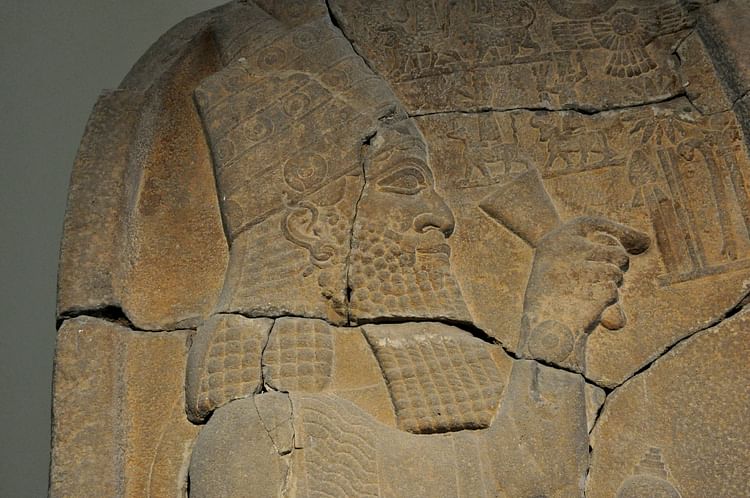
Esarhaddon (reigned 681-669 BCE) was the third king of the Sargonid Dynasty of the Neo-Assyrian Empire. He was the youngest son of King Sennacherib (reigned 705-681 BCE), and his mother was not the queen but a concubine named Zakutu(also known as Naqia-Zakutu, c.701-668 BCE). Esarhaddon is mentioned in the Bible in II Kings 19:37, Isaiah 37:38, and Ezra 4:2. He is best known for re-building Babylon (which his father had destroyed) and for his military campaigns in Egypt. An avid follower of astrology, he consulted oracles on a regular basis throughout his reign, far more than any other Assyrian king.He claimed the gods had ordained him to restore Babylon and cleverly omitted from his inscriptions anything that would implicate Sennacherib in the city ’s fall. In his other diplomatic letters he seems equally careful and maintained, then enlarged, the empire his father had left to him. He died on campaign in Egypt and left the throne to his son, Ashurbanipal.
ASCENT TO THE THRONE
Sennacherib had over eleven sons with his various wives and chose as heir his favorite, Ashur -nadin-shumi, the eldest of those born of his queen. He appointed Ashur-nadin-shumi to rule over Babylon and, while fulfilling his duties, the prince was kidnapped by the Elamites and taken to Elam. Sennacherib mounted an enormous expedition to retrieve his son but was defeated. It is thought that Ashur-nadin-shumi was then killed by his captors sometime around 694 BCE. After the defeat of the Assyrian army by the Elamite coalition, Sennacherib returned to his capital at Nineveh and busied himself with building projects and running his empire. He needed to choose a new heir but seems to have taken his time in deciding who that would be. It could be that, during this time, he was evaluating his sons, or it could simply be that he was still grieving the loss of his favorite and did not wish to replace him. In any case, it was not until 683 BCE that Sennacherib declared Esarhaddon heir.
HE REBUILT THE ENTIRE CITY: TEMPLES, HOMES, AND STREETS. AND TO MAKE SURE EVERYONE WOULD REMEMBER THEIR BENEFACTOR, INSCRIBED THE BRICKS AND STONES WITH HIS NAME.
His older brothers did not take the news well. In Esarhaddon's inscriptions he writes:
Of my older brothers, the younger brother was IBut by decree of [the gods] Ashur and Shamash, Bel and Nabu
My father exalted me, amid a gathering of my brothers:
He asked Shamash, “Is this my heir?”
And the gods answered, “He is your second self.”
And then my brothers went mad.
They drew their swords, godlessly, in the middle of Nineveh.
But Ashur, Shamash, Bel, Nabu, Ishtar,
All the gods looked with wrath on the deeds of these scoundrels,
Brought their strength to weakness and humbled them beneath me.
While his inscription tells the basic story, it is not the whole one. It appears that, after Sennacherib announced his choice, the brothers made clear their displeasure and Zakutu sent Esarhaddon into hiding. Exactly where he went is unknown, but it was somewhere in the region formerly held by the Mitanni. In c. 689 BCE Sennacherib had sacked and destroyed the city of Babylon, carrying off the statue of the great god Marduk, and this had not met with the approval of the Assyrian court or the people of the empire. Babylon and Assyria shared many of the same gods, and an affront to Marduk of Babylon was a sacrilege which could not be tolerated. In 681 BCE Sennacherib was assassinated by two of his sons. While they certainly could have been motivated to kill him to take the throne (and so cut Esarhaddon off from his inheritance), they would have required some form of justification, and the destruction of Babylon would have served that purpose well. Their names are not known outside of the biblical versions given in II Kings 19 and Isaiah 37:38 where they are called Adrammelech and Sharezer.Following the assassination, the two princes fled Nineveh and sought refuge with the king of Urartu, Rusas II.
At this point Esarhaddon was re-called from exile and fought his brother's factions for the throne. After a six-week civil war, he emerged victorious, executed his brother's families, associates, and all who had joined their cause, and took the throne.
REIGN & RESTORATION OF BABYLON
Among his first decrees was the restoration of Babylon. In his inscription he writes:
Great king, mighty monarch, lord of all, king of the land of Assur, ruler of Babylon, faithful shepherd, beloved of Marduk, lord of lords, dutiful leader, loved by Marduk's Consort Zurpanitum, humble, obedient, full of praise for their strength and awestruck from his earliest days in the presence of their divine greatness [am I, Esarhaddon].When in the reign of an earlier king there were ill omens, the city offended its gods and was destroyed at their command. It was me, Esarhaddon, whom they chose to restore everything to its rightful place, to calm their anger, to assuage their wrath. You, Marduk, entrusted the protection of the land of Assur to me. The Gods of Babylon meanwhile told me to rebuild their shrines and renew the proper religious observances of their palace, Esagila. I called up all my workmen and conscripted all the people of Babylonia. I set them to work, digging up the ground and carrying the earth away in baskets (Kerrigan, 34).
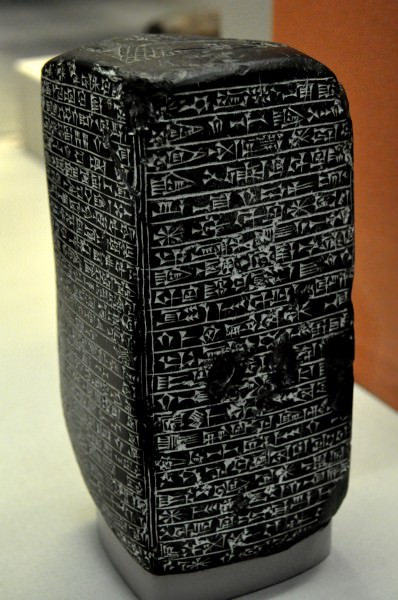
Stone Monument of Esarhaddon
Esarhaddon carefully distanced himself from his father's reign and, especially, from the destruction of Babylon. Even though he identifies himself as the son of Sennacherib and grandson of Sargon II in other inscriptions, in order to make clear that he is the legitimate king, in his inscriptions concerning Babylon he is simply the king whom the gods have ordained to set things right. Sennacherib is only referenced as “an earlier king” in a former time. The propaganda worked, in that there is no record that he was associated in any way with the destruction of the city, only with the re-building. His inscriptions also claim that he personally participated in the restoration project. The historian Michael Kerrigan comments on this, writing :
Esarhaddon believed in leading from the front, taking a central role in what we nowadays call the `groundbreaking ceremony' for the new Esagila. Once the damaged temple had been demolished and its site fully cleared, he says, “I poured libations of the finest oil, honey, ghee, red wine, white wine, to instil respect and fear for the power of Marduk in the people. I myself picked up the first basket of earth, raised it on to my head, and carried it” (35).
He rebuilt the entire city, from the temples to the temple complexes to the homes of the people and the streets and, to make sure everyone would remember their benefactor, inscribed the bricks and stones with his name. The historian Susan Wise Bauer writes:
He wrote his own praises into the very roads underfoot: scores of the bricks that paved the approach to the great temple complex of Esagila were stamped, “For the god Marduk, Esarhaddon, king of the world, king of Assyria and Babylon, made the processional way of Esagila and Babylon shine with baked bricks from a ritually pure kiln (401).
Although the prophecies concerning the re-building of Babylon had said that the city would not be restored for 70 years, Esarhaddon manipulated the priests to read the prophecy as eleven years. He did this by having them read the cuneiformnumber for 70 upside down so that it meant eleven, which was exactly the number of years he had planned for the restoration.Since he maintained a life-long interest in astrology and prophecy, it has seemed strange to some scholars that he would manipulate the priests in this way and discredit the integrity of the oracles. It seems clear, however, that he had a very clear vision for his reign and, even though he did believe in the signs from the gods, he was not going to allow that belief to stand in the way of achieving his objectives.
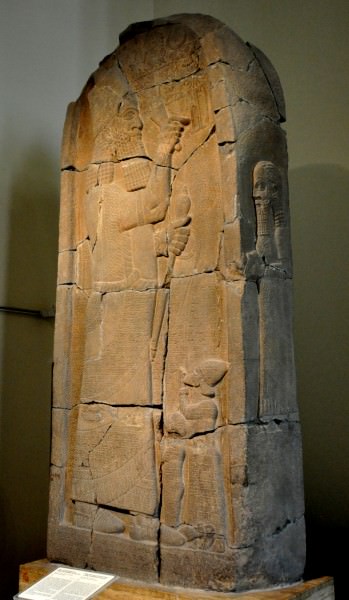
Sam'al Stele of King Esarhaddon
MILITARY CAMPAIGNS
With Babylon restored, Esarhaddon set about expanding and improving upon his empire. The Cimmerians, a nomadic tribe of the north, were threatening his western borders, and the Kingdom of Urartu, which his grandfather had defeated in 714 BCE, had risen again in the north. His two brothers, who had killed their father, were still there under the protection of King Rusas II who, like the Urartu kings before him, had no love for the Assyrians. In order to keep the Cimmerians at bay, Esarhaddon entered into a treaty with the Scythians, another nomadic tribe known for their skill in cavalry warfare. Although he felt he needed their help, he did not trust them as allies. Esarhaddon consulted his oracles regarding Urartu, the Cimmerians, and the Scythians, and his questions are preserved on divination tablets (prayers or requests inscribed on tablets which were then read in the temple in the presence of the god). Two of his tablets read:
Shamash, great lord, will Rusas, king of the Urartu, come with his armies, and the Cimmerians (or any of his allies), and wage war, kill, plunder, and loot?Shamash, great lord, if I give one of my daughters in marriage to the king of the Scythians, will he speak words of good faith to me, true and honest words of peace? Will he keep my treaty and do whatever is pleasing to me?
While Esarhaddon was consulting the oracles, the Cimmerians invaded from the west in 679 BCE. By 676 BCE they had fought their way further into Assyrian-held lands and conquered Phrygia (roughly modern-day Turkey ), destroying the citiesand temples. Esarhaddon met the Cimmerians in battle at Cilicia and defeated them. He claims in his inscriptions to have killed their king, Teushpa, with his own sword.
At the same time the Cimmerians had invaded, the city of Sidon in the Levant rebelled against Assyrian rule and Esarhaddon marched down the coast of the Mediterranean Sea, defeated the rebel king, and executed him. He then turned about and marched against the allies of Urartu, the Mannaeans, to the north-east and, by early 673 BCE, was at war with Urartu itself.What happened to his brothers is unknown, but Urartu was again beaten back by the Assyrian army and, if the brothers were still alive when Esarhaddon defeated the Urartu, he would no doubt have had them executed.
THE EGYPTIAN CAMPAIGNS & DEATH
Having now secured his borders, Esarhaddon thought to expand them. Egypt had been a problem for the Assyrians in his father's reign and was still encouraging dissent and revolt in the Assyrian Empire. In 673 BCE Esarhaddon launched his first military campaign against Egypt and, thinking to storm Egypt in one furious push, marched his army at great speed. This proved to be a mistake. When they met the Egyptian forces under the Kushite Pharaoh Tirhakah outside the city of Ashkelon, the Assyrians were exhausted and quickly defeated. Esarhaddon withdrew from the field and his army limped back to Nineveh.
Esarhaddon learned from his mistake and, in 671 BCE, took his time and brought a much larger army slowly down through Assyrian territory and up to the Egyptian borders; then he ordered the attack. The Egyptian cities fell quickly to the Assyrians and Esarhaddon drove the army forward down the Nile Delta and captured the capital city of Memphis. Although Tirhakah escaped, Esarhaddon captured his son, wife, family, and most of the royal court and sent them, along with much of the population of Memphis, back to Assyria. He then placed officials loyal to him in key posts to govern his new territory and returned to Nineveh. His victory is commemorated on his famous Victory Stele of 671 BCE now in the Pergamon Museum of Berlin, Germany. The stele depicts Esarhaddon in his full majesty, holding a war mace, with an attendant king kneeling at his feet and Tirhakah's son, also kneeling abjectly, with a rope around his neck.
His eldest son and heir, Sin-iddina-apla, had died in 672 BCE, and Esarhaddon now chose his second son, Ashurbanipal, as his successor. He forced his vassal states to swear loyalty in advance to Ashurbanipal in order to avoid any revolts over the future succession. At about this same time, Esarhaddon's mother Zakutu issued the Loyalty Treaty of Naqia-Zakutu which compelled the Assyrian court and those territories under Assyrian rule to accept and support the reign of Ashurbanipal. In order to avoid the kind of conflict he had gone through with his brothers, Esarhaddon also provided for his youngest son, Shamash-shun-ukin, by decreeing he should be king of Babylon.
Esarhaddon seems to have just finished setting his affairs in order when news reached him that Egypt had rebelled. Many of the trusted officials he had left in charge of cities and provinces had become sympathetic to Egyptian liberation and, no doubt, were profiting handsomely from their positions and were disinclined to send tribute back to Nineveh. In 669 BCE, Esarhaddon mobilized his army and marched again on Egypt; he died before he reached the borders. It would be left to Ashurbanipal to complete his father's work and conquer Egypt for the Assyrian Empire.
The Phoenicians - Master Mariners › Antique Origins
Ancient Civilizations
Driven by their desire for trade and the acquisition of such commodities as silver from Spain, gold from Africa, and tin from the Scilly Isles, the Phoenicians sailed far and wide, even beyond the Mediterranean's traditional safe limits of the Pillars of Hercules and into the Atlantic. They were credited with many important nautical inventions and firmly established a reputation as the greatest mariners in the ancient world. Phoenician ships were represented in the art of their neighbours, and their seamanship is praised above all other by such ancient writers as Homer and Herodotus. If any nation could claim to be the masters of the seas, it was the Phoenicians.

Phoenician Small Ship
LEAVING THE HOMELAND
The Phoenicians became sailors in the first place because of the topography of their homeland, the narrow mountainous strip of land on the coast of the Levant. Travelling between settlements, usually located on rocky peninsulas, was much easier by sea, especially when carrying such cumbersome cargo as cedar wood logs for which the Phoenicians were famed. It was thanks to the very same wood the Phoenicians were never short of the necessary raw materials to build their ships. The Phoenicians also preferred the security of small islets just off the coast, the classic example being the great city of Tyre, so that ships were the most practical means of transport.
HEMMED IN BY MOUNTAINS, WHEN THE TIME CAME, THE NATURAL DIRECTION OF PHOENICIAN EXPANSION WAS NOT INLAND BUT THE SEA.
Hemmed in by mountains, then, when the time came, perhaps from the 12th century BCE, the natural direction of Phoenician expansion was not inland but the sea. As a result of this search for new resources such as gold and tin, the Phoenicians became accomplished sailors, creating an unprecedented trade network which went from Cyprus, Rhodes, the Aegeanislands, Egypt, Sicily, Malta, Sardinia, central Italy, France, North Africa, Ibiza, Spain and beyond even the Pillars of Hercules and the bounds of the Mediterranean. In time, this network transformed into an empire of colonies so that the Phoenicians criss-crossed the seas and gained the confidence to reach such far-flung places as ancient Britain and the Atlantic coast of Africa.
PHOENICIAN SHIPS
The Phoenicians were famed in antiquity for their ship-building skills, and they were credited with inventing the keel, the battering ram on the bow, and caulking between planks. From Assyrian relief carvings at Nineveh and Khorsabad, and descriptions in texts such as the book of Ezekial in the Bible we know that the Phoenicians had three types of ship, all shallow-keeled. Warships had a convex stern and were propelled by a large single-masted square sail and two banks of oars (a bireme ), had a deck, and were fitted with a ram low on the bow.
The second ship type was for transport and trade purposes. These were similar to the first type but, with wide, big-bellied hulls, they were much heavier. They perhaps had higher sides too in order to permit the stacking of cargo on deck as well as below, and they had both a convex stern and bow. Their cargo capacity was somewhere in the region of 450 tons. A fleet might consist of up to 50 cargo vessels, and such fleets are depicted in reliefs being escorted by a number of warships.
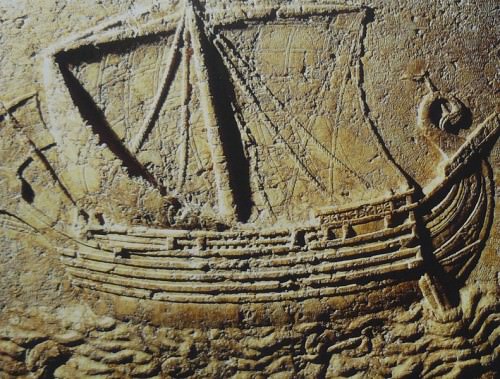
Phoenician Ship
A third type of vessel, also for trade use, was much smaller than the other two, had a horse-head at the bow and only one bank of oars. Due to its size, this vessel was only used for coastal fishing and short trips. No Phoenician ship has been recovered intact by maritime archaeologists but judging by the pictorial evidence the ships would have been difficult to handle.It is also worth noting that the more oarsmen a ship had then the less room there was for cargo. Greater manoeuvrability was, therefore, achieved by adjusting the sail when necessary and the use of a double sailing oar.
Ancient ships were far from easy to handle but in antiquity the Phoenicians were widely known as the best sailors around.Herodotus describes one episode during the build up to the second Persian invasion of Greece in 480 BCE led by Xerxes.The Persian king wanted to put his multi-national fleet through their paces and so organized a sailing race, which the sailors from Sidon won. Herodotus also mentions that Xerxes always made sure to travel on a Phoenician ship whenever he had to go anywhere by sea.
NAVIGATION
The Phoenicians did not have the compass or any other navigational instrument, and so they relied on natural features on coastlines, the stars, and dead-reckoning to guide their way and reach their destination. The most important star to them was the Pole Star of the Ursa Minor constellation and, by way of a compliment to their sea-faring skills, the Greek name for this group was actually Phoenike or 'Phoenician'. Some maps of coastal stretches are known to have existed but were unlikely to have been used during a voyage. Rather, navigation was achieved through the position of the stars, sun, landmarks, direction of the winds, and the experience of the captain of tides, currents and winds on the particular route being taken. Close to shore, Herodotus mentions the use of sounding leads to measure the sea depth, and we know that Phoenician ships had a crow's nest for greater visibility.
Historians long considered that the Phoenicians sailed only during the day-time as they had to keep close to the shoreline and within sight of landmarks; at night they, therefore, had to beach or anchor their ships and this explained the proximity of some Phoenician colonies, a day's sailing distance from each other. This simplistic view has been revised in recent years. First and foremost, the often mountainous coastline of the Mediterranean means that one can sail a great distance from land and still keep high landmarks in sight, a strategy still used by many local fishermen today. Indeed, the areas of sea where it is not possible to sight land of some sort are remarkably few in the Mediterranean, and these are places ancient mariners would have had no interest in crossing anyway. In addition, it can actually be more dangerous sailing close to a coast than out to sea where there are no rocks or unpredictable currents.
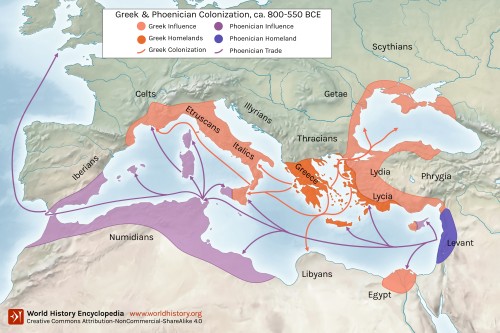
Greek and Phoenician Colonization
Neither does the traditional view take into account that the Phoenicians used astronomical observations at night. Further, many Phoenician settlements were either much closer than a day's sailing distance or much further, for example, Ibiza is 65 straight miles from Iberia. The same can be said for Sardinia and Sicily, and there is also evidence that the Phoenicians made use of even more remote smaller islands as stopping points. It seems reasonable to assume, then, that Phoenician navigators, at least in fine weather, would have chosen the shortest direct route between two points and not necessarily hugged the coast or stopped each night as much as once thought. The non-stop voyages described in both Hesiod and Homer would seem to deserve more credit as to their accuracy. It is true that in foggy or rainy weather landmarks and stars become useless but that is probably why the Phoenicians restricted their sailing season to the period between late spring and early autumn, when the Mediterranean climate is remarkably stable.
SEA ROUTES
Both Herodotus and Thucydides agree that the average speed of an ancient vessel was around 6 miles per hour, and therefore, taking into account stops for bad weather, rest etc., it would have taken, for example, 15 days to sail (and sometimes row) from Greece to Sicily. Colaios sailed from Samos to Gadir (in southern Spain), a distance of 2,000 miles, in the 7th century BCE, and that would have taken around 60 days. Long voyages, then, would frequently have required winter stop-overs and continuing in the next sailing season. Herodotus mentions this fact, even describing how the mariners were able to grow their own wheat as they waited. So, from one end of the Phoenician world to the other - Tyre to Gadir (over 1,600 miles) - might have taken 90 days or a full sailing season; the ship would have unloaded and re-loaded cargo and made the journey back the next year.

Phoenician Trade Network
The actual routes taken by the Phoenicians are much debated, but if we assume the currents of the Mediterranean have not changed since antiquity, then it seems likely that ancient mariners took advantage of the long-distance currents used by sailors today. The route west, then, would probably have been via Cyprus, the coast of Anatolia, Rhodes, Malta, Sicily, Sardinia, Ibiza, and along the coast of southern Spain to silver-rich Gadir. The homeward journey would have benefitted from the current which sweeps back right through the centre of the Mediterranean. This would give two possible routes: to Ibiza and then Sardinia, or to Carthage on the North African coast and then to either Sardinia or direct to Malta, and then Phoenicia. It is no surprise that at each of these vital strategic stopping points the Phoenicians created colonies which, in effect, cut out, at least for a few centuries, competing trading cultures such as the Greeks.
FAMOUS VOYAGES
The Phoenicians were not limited to the Mediterranean and the Atlantic, they also sailed down the Red Sea and possibly the Indian Ocean too. The book of I Kings in the Bible describes a Phoenician expedition during the 10th century BCE to a new land called Ophir in order to acquire gold, silver, ivory, and gems. The location of Ophir is not known but is variously considered to be in the Sudan, Somalia, Yemen, or even an island in the Indian Ocean. The ships of this fleet were built at Eziongeber on the Red Sea coast and funded by King Solomon. The great distance covered is suggested by the description that the expedition was repeated only every three years.
The ancient historian Diodorus claimed that the Phoenicians reached the Atlantic islands of Madeira, the Canary Islands, and the Azores. There is, though, no archaeological evidence of direct Phoenician contact, only the discovery in 1749 CE of eight Carthaginian coins dating to the 3rd century BCE. Just how they got there can only be speculated upon.
LICENSE:
Article based on information obtained from these sources:with permission from the Website Ancient History Encyclopedia
Content is available under License Creative Commons: Attribution-NonCommercial-ShareAlike 3.0 Unported. CC-BY-NC-SA License